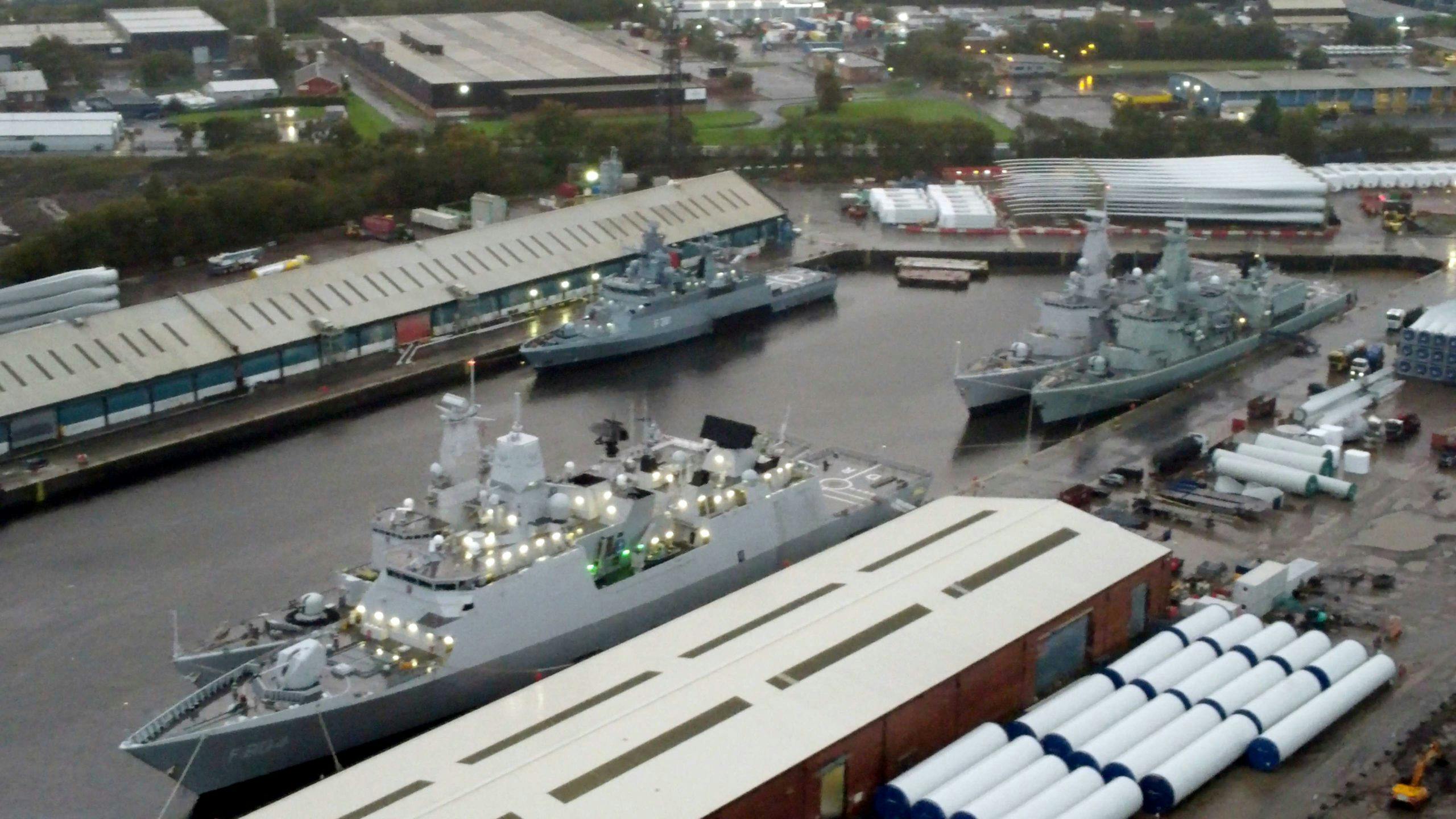A number of NATO warships have arrived in Glasgow ahead of Exercise Strike Warrior, a major multinational naval exercise set to take place off the coast of Scotland.
The ships docked at Glasgow’s King George V dock are frigates and corvettes from Portugal, Belgium, the Netherlands, and Germany, each bringing unique capabilities to the exercise.
Here’s a breakdown of the warships that have arrived so far:
- Dom Francisco de Almeida (F334): A Vasco da Gama-class frigate of the Portuguese Navy, Dom Francisco de Almeida is equipped with Harpoon anti-ship missiles, a 76mm OTO Melara gun, and two triple torpedo tubes for anti-submarine warfare. It has a displacement of 3,200 tons, a top speed of 32 knots, and is powered by a CODOG (Combined Diesel or Gas) propulsion system.
- B.N.S. Louise-Marie (F931): A Belgian Karel Doorman-class frigate, Louise-Marie is equipped with Sea Sparrow surface-to-air missiles, Harpoon anti-ship missiles, a 76mm naval gun, and two Mark 46 torpedo launchers. It has a displacement of 3,320 tons, a top speed of 30 knots, and features diesel propulsion.
- H.N.L.M.S. De Ruyter (F804): A De Zeven Provinciën-class frigate of the Royal Netherlands Navy, De Ruyter features APAR and SMART-L radars, SM-2 surface-to-air missiles, Harpoon anti-ship missiles, a Goalkeeper CIWS, and torpedo launchers. It has a displacement of 6,050 tons, a top speed of 30 knots, and is powered by a COGAG (Combined Gas and Gas) propulsion system.
- H.N.L.M.S. Van Amstel (F831): A Karel Doorman-class frigate of the Royal Netherlands Navy, Van Amstel is equipped with Sea Sparrow missiles, Harpoon anti-ship missiles, a 76mm OTO Melara gun, and two triple torpedo tubes. It has a displacement of 3,320 tons, a top speed of 30 knots, and uses a diesel propulsion system.
- F.G.S. Magdeburg (F261): A German Braunschweig-class corvette, Magdeburg is armed with RBS-15 Mk3 anti-ship missiles, a 76mm naval gun, and two MLG 27mm autocannons. It also features RAM (Rolling Airframe Missile) for close-in air defense. The corvette has a displacement of 1,840 tons, a top speed of 26 knots, and is powered by two diesel engines.
These warships, now docked in Glasgow, will take part in a series of complex drills aimed at enhancing interoperability between NATO navies, as part of Exerise Strike Warrior.
What is Strike Warrior?
Exercise Strike Warrior is a major naval training event held by the Royal Navy, designed to enhance combat readiness and strengthen interoperability among allied forces. Taking place off the coast of Scotland, the exercise involves a wide array of naval assets, including surface ships, submarines, and air units, such as the UK Carrier Strike Group (CSG).
HMS Prince of Wales, one of the Royal Navy’s Queen Elizabeth-class aircraft carriers, plays a central role, alongside other vessels like HMS Iron Duke. The training scenarios during Strike Warrior include simulated air and missile attacks, anti-submarine warfare, and surface combat exercises, providing a rigorous test of the fleet’s capabilities.
The exercise also serves as a crucial preparation stage for future deployments, ensuring that the Royal Navy and its allies remain ready to respond to global threats.
It brings together forces from NATO allies and partner nations, fostering coordination and tactical skill development among participants. By simulating high-intensity combat operations, Strike Warrior aims to ensure that participating units, including aircraft, frigates, and destroyers, are well-prepared to meet the challenges of naval warfare.















Dom Francisco de Almeida is also a Karel Doorman class frigate, just “rebranded”..
N.R.P. Dom Francisco de Almeida is a Karel Doorman-class frigate, and not a Vasco da Gama class frigate.
Dunno, probably a faulty perception, but article lead photograph evoked an involuntary memory of photos of Battleship Row, Pearl Harbor, 7 Dec 1941. Hopefully, warships will not be berthed in harbors, multiple abreast, if hostilities are imminent. 🤞
The threats have changed since a lot of navies ships were designed. With missiles, flying drones, sea drones, on top of the usual aircraft, ships, submarines to deal with.
I do wonder if a lot of these drones would even get close to a ship with the ECM turned on.
Mostly they wouldn’t get anywhere near a warship with the radar turned up to high power never mind ECM and EW or CIWS or 30/40mm.
There is a big difference between MILSPEC and consumer grade electronics and it takes more than a tin foil wrap to make something electromagnetically resitant!
Just to give some perspective on the difference in RF fields a typical commercial drone for home use will have to cope with 3v/m to 10v/m field strength. At the other end of the scale critical systems on a civil aircraft have to work up to 3000 v/m. If I remember for Aegis it’s at least 22000 v/m if you fly past the main beam. Frying tonight….
Do th ECM cover their frequencies?
The frigates Dom Francisco de Almeida, BNS Louise Marie and HNLMS Van Amstel all belong to the Dutch Karel Doorman class. All have CODOG propulsion, as is the case with HNLMS De Ruyter.
Sounds like the UK contribution will be PoW, Iron Duke, Dauntless, Astute and a Tide. Am I missing anyone?
Yes the RN have two frigates taking part, I think it is HMS Portland?
I believe Somerset has also been in the area providing TAPS support for the Clyde however, I don’t believe she’s taking part. Still a very healthy force heading up there, especially compared to the abysmal show we put on for Steadfast Defender earlier in the year.
Any idea when and where would be a good place to watch these vessels….?